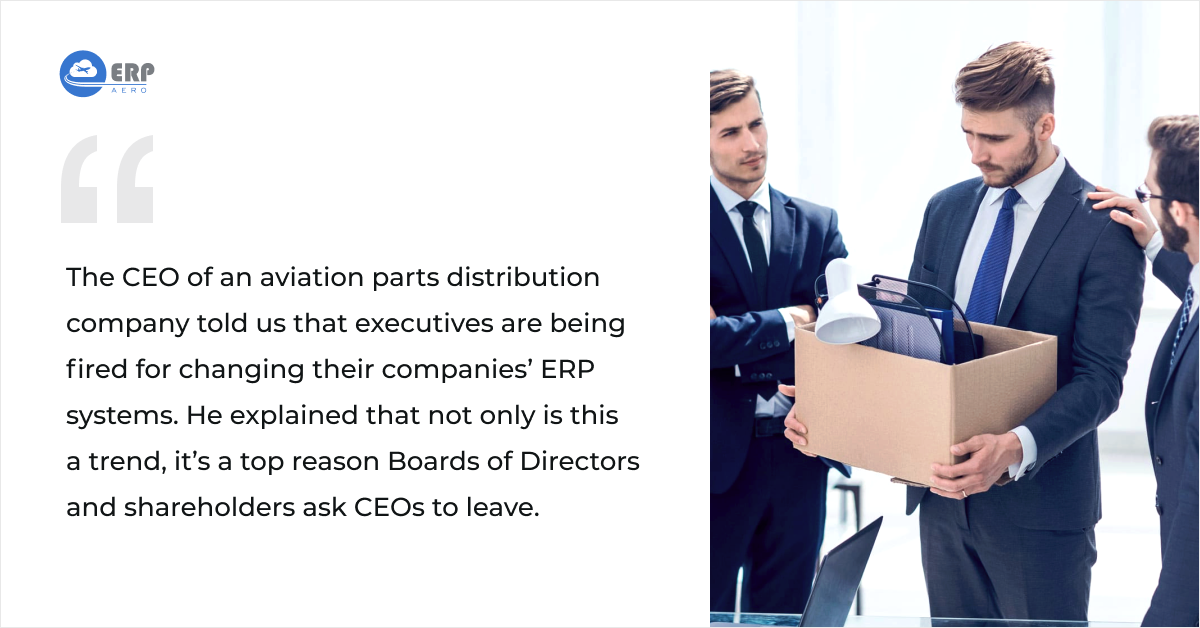Executed well, Enterprise Resource Planning (ERP) systems streamline business processes, reduce costs, and lead to unmatched potential for increasing efficiency, precision, and quote-to-business conversions. Yet, despite the opportunity for growth with the introduction of good ERP software, executives tread carefully.
Earlier this year at the 2020 Aeroxchange Conference held in Los Angeles, the CEO of an aviation parts distribution company told us that executives are being fired for changing their companies’ ERP systems. He explained that not only is this a trend, it’s a top reason Boards of Directors and shareholders ask CEOs to leave. After the conference, we sat down, looked for proof of his story, and found his words to be true: implementation of ERP software has resulted in high-profile failures that are hard to forget.

However, the problem isn't ERP itself, and it has little to do with the decision to implement new ERP software. After digging into the mistakes that led to failure, we identified solutions to ensure success with a new ERP setup and to help CEOs avoid pitfalls that could spoil the huge potential of their ERP.
Choose the Correct ERP System for Your Company.
It’s impossible to create one-size-fits-all ERP software and a mistake to expect buy-and-configure systems to make the cut for all companies of all sizes, across all industries, everywhere. Legacy platforms do not typically leave room for customization, and homegrown solutions pose significant limitations. SAP might work well for big companies, but the optimal selection for small to medium enterprises lies elsewhere.

Ideally, CEOs identify an ERP partner that’s privy to the needs of their company and will implement changes in response to their company’s evolution (not the other way around).
Establish a Direct Channel Between Your Business and Your ERP Partner.
Implementation partners, too, play an important role in the successful (or unsuccessful) launch of a new ERP system and assurance of its sustained workability. Finding an ERP partner that also acts as your implementation partner can mitigate misunderstanding and miscommunication.

Acknowledge the Attention Needed to Execute a New ERP System Successfully.
Assuming that an ERP system will work automatically upon purchase sends executives down an ominous path. CEOs must facilitate the success of new ERP software implementation by dedicating time and resources to walking the ERP partner through all aspects and processes of their business. This ensures delivery of a well-tested, well-tailored platform. The ERP system must satisfy unique needs and activities of a business in a simple and efficient manner.
This is the Legacy of the CEO.
Letting go of archaic ERP systems isn’t easy. They met our needs in the past, and yes, they still function. However, legacy and homegrown systems do not position companies competitively in the present or future. Implementing a new ERP system is a necessary transition that requires courage and dedication from executives.

Executives can navigate the implementation smartly by vetting ERP suppliers, touring software, asking for references, identifying the right implementation partner, and ensuring time and resources are allocated to the transition. By equipping their companies with the right MRO ERP software, CEOs take business to the next level, outperform competitors, and provide their customers with precise, seamless, and efficient products and services.
References
- Fruhlinger, J. (2020, March 20). 16 famous ERP disasters, dustups and disappointments
Illustration Credits
- Vlad Prokhorenko Director of Creative Services @ ERP.Aero
We want to hear what you think: please share your thoughts in the ERP.aero community at https://community.erp.aero.

